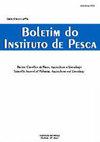亚马孙毛柳果浆对凡纳滨对虾幼虾氨和亚硝酸盐毒性的化学保护作用
IF 0.6
4区 农林科学
Q4 FISHERIES
引用次数: 1
摘要
毛茛“布里蒂”的化学保护作用(纳入饮食:0对照组;1.25;2.50;5.00;和10.00% W/W)对凡纳滨对虾(Litopenaeus vannamei)仔鱼(PL)暴露于氨和亚硝酸盐的影响。分析的变量包括抗氧化(ACAP)和氧化损伤(TBARS)反应和总类胡萝卜素水平。结果表明,饲粮间动物技术指标无显著差异(p < 0.05)。PL类胡萝卜素含量(R2 = 0.86)、ACAP含量(R2 = 0.78)和TBARS含量(R2 = 0.91)与“buriti”的添加水平呈剂量依赖关系(p <0.05)。43 d后,将幼虾暴露于氨(0.48 mg NH3-N -1)或亚硝酸盐(40 mg NO3 -1)中96 h。在含有2.50%和5.00%“buriti”(氨暴露)或5.00和10.00%(亚硝酸盐暴露)的“buriti”内含物的PL中,观察到对过氧自由基的清除活性更高。用10.00%的“buriti”饲喂氨处理的对虾还原性谷胱甘肽含量较高。暴露于氨或亚硝酸盐和先前添加高于2.50%“buriti”的饲料的虾的脂质过氧化水平较低。在氨或亚硝酸盐暴露的生物体中,清除活性的增加和脂质过氧化的降低,以及之前补充的“buriti”,表明了一种激发反应,增加了南美扁豆应对含氮化合物的弹性,表明这种水果被用作化学保护剂。本文章由计算机程序翻译,如有差异,请以英文原文为准。
Chemoprotection of amazonian Mauritia flexuosa fruit pulp against ammonia and nitrite toxicity to postlarvae shrimps Litopenaeus vannamei
The chemoprotection of “buriti” Mauritia flexuosa (inclusion in diet: 0-control group; 1.25; 2.50; 5.00; and 10.00% W/W) to Litopenaeus vannamei postlarvae (PL) exposed to ammonia or nitrite was investigated. Analyzed variables include antioxidant (ACAP) and oxidative damage (TBARS) responses and levels of total carotenoids. The results indicated that there was no significant difference (p >0.05) in zootechnical variables between diets. The PL carotenoid content (R2 = 0.86), ACAP (R2 = 0.78), and TBARS (R2 = 0.91) showed a dose-dependent relationship with the inclusion levels of “buriti” (p <0.05). After 43 days, juvenile shrimps were exposed for 96 h to ammonia (0.48 mg NH3-N L-1) or nitrite (40 mg NO3 L-1). Higher scavenging activity against peroxyl radicals was observed in PL fed with 2.50 and 5.00% of “buriti” (ammonia exposure), or 5.00 and 10.00% (nitrite exposure) of “buriti” inclusion. Content of reduced glutathione was higher in shrimps exposed to ammonia and fed with 10.00% of “buriti”. Lipid peroxidation levels were lower in shrimps exposed to ammonia or nitrite and previously fed with inclusion higher than 2.50% of “buriti”. The increased scavenging activity and lower lipid peroxidation in ammonia or nitrite-exposed organisms and previously supplemented with “buriti” point to a hormetic response that increases the resilience of L. vannamei to cope with nitrogenous compounds, pointing to the use of this fruit as a chemoprotectant agent.
求助全文
通过发布文献求助,成功后即可免费获取论文全文。
去求助
来源期刊

Boletim do Instituto de Pesca
FISHERIES-ZOOLOGY
CiteScore
0.80
自引率
0.00%
发文量
24
审稿时长
>12 weeks
期刊介绍:
To publish original articles of research and short communications in the following áreas: Fisheries, Aquaculture, Zootechnology, Limnology, Oceanography, Biology and Pathology of aquatic organisms. The publication depends on the approval of the Editorial Board, based on the peer review.
 求助内容:
求助内容: 应助结果提醒方式:
应助结果提醒方式:


